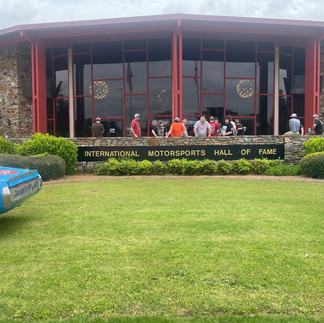The South’s revenge: NASCAR & SEC Football
- Bob Ford

- May 29
- 5 min read
If you love history, we are seeking sponsors to support this column. Contact Rob at the Globe, 417-334-9100, for details. Your customers will appreciate it.
Want to learn more about history in another format? Check out my YouTube videos under Bob Ford’s History, Mystery and Lore. There you will find a dozen eight- to fifteen-minute shorts on interesting topics. Wanting to take these videos to the next level? Contact me, robertmford@aol.com to discuss.
My first behind the wheel experience was driving on the Daytona International Speedway. I’ll let that sink in for a minute.
In the meantime, we will tackle SEC Football in a couple months after the season starts.
Stock car racing traces its origin back to moonshine running during prohibition, mostly in the thirsty state of North Carolina. “Runners,” turned competitive. Not only did they have to outrun the law, they liked outrunning each other. Think of the 1958 movie, “Thunder Road,” with Robert Mitchum.
Most moonshiners came out of Appalachia. Delivering their product to market was critical, almost as important as not being caught. Cars got faster, driving more daring, all to get to the end of the road and that satisfied customer. Drivers kept on modifying their cars trying to outperform their competition and get an edge.
Bill France Sr. saw an opportunity and started promoting “moonshiner,” stock car racing in Florida. Between 1905-37, competition on the Daytona Beach Road Course grew and grew in popularity. There were two straightaways – one on the beach and the other on famed State Highway A1A with nasty grooved corners connecting.
In 1947 France organized the National Association of Stock Car Auto Racing headquartered in Daytona Beach. NASCAR was off and running.
Next, France needed a track. After many failed attempts, finally the Daytona Speedway was built in 1952 on the site of an old Air Force Base. It was the first of its kind and propelled the sport to the next level.
Bill France was never satisfied. He wanted a longer, faster track with more grandstands. State and local governments were realizing the popularity of the sport and wanted their piece of the action. France couldn’t find a friendly economic situation until Governor George Wallace of Alabama stepped in and Talladega Raceway was born. Just 50 miles east of Birmingham, 100 west of Atlanta and 30 miles to the closest Buc-ee’s, Talladega worked.
The track opened in 1969, able to hold 175,000 spectators. It’s the longest tri-oval with some of the steepest banks of any of the six superspeedways in the United States. A record speed of 221 mph at Talladega was set by Rusty Wallace in 2004, the fastest a stock car has gone on a track.
At immense speeds, cars tend to go airborne causing massive wrecks. Restrictor plates were added in 1988 to slow cars down because Talladega had become too dangerous for the sport.
“Aerodynamics are for people who can’t build engines,” famously said Enzo Ferrari.
Many eerie incidents have taken place at the racetrack including spectacular pile-ups and unusual deaths, adding to what many call the Talladega jinx. Legend has it, Talladega Valley was home to the Creek Nation, a Native American Tribe who was driven off their land by Andrew Jackson. A Creek shaman is said to have cursed the valley.
Another myth has it the track was built on an old Indian burial ground and yet another says a native chief was horse racing, thrown off and killed near the track site.
Whichever one caused it, strange happenings have plagued the track from the outset including an infield helicopter crash killing driver Davey Allison.
In 1973 Bobby Isaac was leading the race when he quickly pulled into the pits, got out of his car and refused to get back in because he heard voices telling him to quit. He stopped racing for a year.
On site along with the track, the International Raceway Hall of Fame is located just outside the main gate. The Hall enshrines people that have had an impact on the sport. Along with individuals, winning cars, wrecked cars, banners, helmets, trophies and a slew of memorable posters, the museum even smells like pit row.
All the greats are enshrined: the Frances, Neil Bonnett, the Allison brothers, Craig Breedlove, Petty, Gordon, Earnhart, Andretti, Elliott, Baker and so many others. “It’s a wonderful walk through for any NASCAR fan,” smiles Sheila Bain, the museum’s gatekeeper.
The sport itself became part of life in the good-ole-boy South where sentiments die hard. For the early decades this was an all white sport. You would see Confederate battle flags dotting every race's infield. Not until black driver Bubba Wallace, whose first win was at Talladega driving for Richard Petty Racing, upset the apple cart forcing a long overdue change to take place.
Attitudes have mellowed. In 2020 the battle flags were banned. NASCAR now actively markets to black fans, and talented minority drivers are encouraged to become a part, but sponsorships and opportunities are tough to come by.
OK. My father came home from work one evening and asked if I wanted to go with him to a convention for a couple of days in Florida. I was 14 and thinking sun, sand, beaches and girls in bikinis. I’m in!
After arriving in Daytona Beach, we were having dinner in a booth next to Mario Andretti who dropped by our table and invited us…nah, that didn’t happen. I’m pulling your lead foot.
What did happen is Dad signed us up for a tour of the Daytona International Speedway at $6 per. Six of us climbed into a Chevy Sportsvan and drove through a tunnel popping out on the infield. I was shocked at the size of the place. Very cool.
There is a flat paved lane at the bottom of the raceway around the whole track we could drive on. The curves were so steep I was the only one who, on all fours, could climb up just a little. Back on the flat the tour guide stopped and asked if anyone wanted to get behind the wheel and drive the van, allowing them to tell their friends back home they had driven on the Daytona 500 Raceway. Two did it, then one person said, “let the boy drive!” Everybody was up for it but my father.
He knew I’d never driven anything, but he bowed to van pressure. I climbed behind the wheel.
Driving 20 mph for maybe 200 yards on the flat, I put that 250 cubic inch 6 banger through its paces. Our guide was smiling, “you’ll be able to tell this story fifty years from now!” He’s right. I just did.
Hope you enjoyed Memorial Day, watched the Indy 500, thanked a veteran and honored those who influenced your life.
—————————————
You can find more of Bob’s work on his website bobfordshistory.com








![Elvis: ‘Thank you, thank you very much!’ [Part 2]](https://static.wixstatic.com/media/0d906d_3249f8ed3f184358b97f68939ecff86d~mv2.jpg/v1/fill/w_975,h_731,al_c,q_85,enc_avif,quality_auto/0d906d_3249f8ed3f184358b97f68939ecff86d~mv2.jpg)
Comments